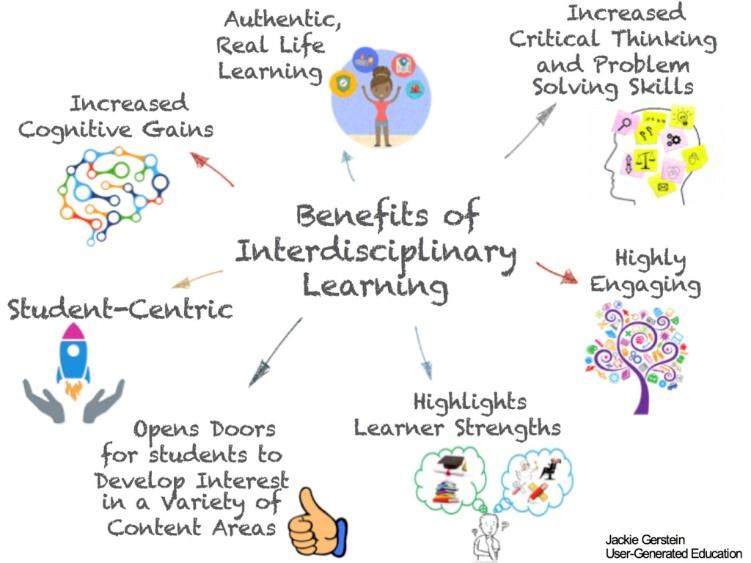
What is IDL in Education Perspective?
Interdisciplinary learning is a way of learning in which learners draw on knowledge, understanding, and skills from two or more subjects to solve a problem, and advance our understanding of a concept or idea that extends beyond the scope of any subject area. Using IDL, students can apply their subject knowledge and language to various new situations and challenges.
IDL in Education refers to a systematic approach to learning that uses connections between various subjects or fields to improve comprehension. On the contrary, subject-based and interdisciplinary learning are mutually reinforcing and interdependent.
IDL relies on a solid foundation of disciplinary knowledge, understanding, and expertise to function correctly. Ideally, it should supplement and enhance subject-specific instruction, facilitate learning across disciplines, and allow students to apply what they’ve learned in new contexts.
What are IDL Aims?
- Students will take part in activities that promote active learning.
- Students will take ownership of their own Education by following their passions.
- Pupils will go on field trips, learn about the local community, and connect to their schoolwork.
- Pupils will learn practical skills that will help them in life, Education, and the workforce.
- Obtaining Senior Phase accreditation is the ultimate goal.
Developing IDL requires a wide range of skills and knowledge. That’s why it’s so common for it to be developed in a team effort. Including postsecondary Education, IDL principles and practices can be applied across all learning and teaching contexts.
IDL: A Broader Term:
The term “integrated design learning” (IDL) is often used (and misused) to refer to a variety of educational approaches involving the integration of disciplinary knowledge, such as multi-disciplinary, project-based, inquiry-based, or problem-based learning.
Interdisciplinary and multi-disciplinary are often used interchangeably when discussing Education. To be interdisciplinary, a subject must be linked to other subjects that are not directly related to it. At the RSE IDL conference, teachers and educators recognized that “contradictory understandings of what IDL is” were a major challenge in implementing IDL.
A concise working definition of IDL is essential because it provides a “benchmark” for its development and practice, even though there are many possible creative contexts, starting points and approaches for the development of IDL and some “fuzziness” and latitude around this definition in practice.
Foundations, Lintels, and Pillars of IDL:
The idea of pillars, lintels, and foundations can be helpful when considering IDL. IDL should be based on a solid foundation of in-depth subject knowledge, comprehension, and proficiency. If the disciplines are the pillars and interdisciplinary work is the lintels of a structure, interdisciplinary learning will lack rigor and utility. The interdisciplinary lintels will fall if the disciplinary pillars are missing.
All subjects, including literacy and numeracy, are supported by a foundation of skills and abilities that include competencies in the following areas:
The modern workplace and the rest of the world demand an ever-increasing integration of both specialist and general knowledge. In most graduate recruitment, subject-specific knowledge is no longer the primary criterion for suitability. IDL, on the other hand, aims to give students more than just job-ready skills; it also aims to cultivate a lifelong passion for learning, creativity, and connection to others.
IDL Disciplines:
A useful reminder of what academic disciplines are and why they play a role in IDL’s development is helpful. In the field of study, domains are defined by distinct objects, concepts, principles, theories, skills and applications that are distinct from one another. Disciplines are established groups of ‘like-minded’ people who speak the same language in schools, colleges, universities, and research institutions alike.
The absence of a universal comprehension and unambiguous definition of what constitutes IDL presents a significant obstacle to the successful implementation. Therefore, one of the most important goals of the education community should be to advance our understanding of IDL and related strategies for connecting the learning of different subjects through various means.
IDL Parameters:
Making connections, providing contexts, developing knowledge and skills, innovation and creativity, and partnership working are some key themes that coalesce around the notion of interdisciplinary in Scottish policy documents. There is a lack of conceptual clarity in policy regarding multi-disciplinary issues.
It can be challenging to distinguish between interdisciplinary and non-interdisciplinary tasks due to factors such as providing contexts and developing knowledge and skills, which can be applied to teaching and learning in different disciplines. Both emphasize the importance of IDL within the curriculum while acknowledging that a lack of teacher understanding is one of the main barriers to implementing it in practice.
Many of the definitions of IDL in these multi-authored documents are derived from previous policy documents, and as a result, their messages are consistent with what has come before. For practitioners like Humes, many anomalies and important questions remain unanswered, despite the stated intentions of each to provide more clarity on the subject.
When it comes to devising an interdisciplinary lesson, where should teachers begin?
Pring acknowledged that the term “integration” was not well defined or applied in Education, and it could be argued that the situation has not improved much. There is a lack of understanding of interdisciplinary scholarship among educators. Nothing has been synthesized, and the debate is spread across professional, academic, governmental, and industrial literature.
It’s also difficult to evaluate IDL work because of a lack of research into multi-disciplinary approaches. In and of itself, the term “interdisciplinary” is ambiguous and prone to misinterpretation. It is partially because it describes a wide range of unrelated activities.
Primary school students doing topic work, secondary school departments working together on a joint project, or university students from various disciplines conducting research can all benefit from this approach. An interdisciplinary umbrella term covers a wide range of contexts.
Graff refers to this as “a storm of semantics” when it comes to the blurring of disciplinary boundaries because of the use of various prefixes (e.g., multi- and cross-). In addition, there are a plethora of IDL frameworks, with little agreement on the phenomenon itself.
Thematic/multi-disciplinary and interdisciplinary, fused, correlated, and core, immersed and networked, curriculum integration, and cross-curricular are some of the organized models and descriptors around this area.
The study of different fields:
To learn a discipline, you must learn the discipline in its entirety. It’s important to remember that school subjects are distinct from academic disciplines in that they draw on various academic fields. Topics are mainly drawn from discrete disciplines like language, mathematics, science and art in primary school in the Scottish context.
A variety of specialists teaches most subjects in secondary school. These are often taught in isolation and the majority of subjects are taught by the same teacher to the same class. While this method gives students a strong foundation in the various fields, it can make it difficult to draw connections between them.
The Munn Report which helped shape the structure of secondary schools in Scotland highlighted this difficulty. When teaching subjects in isolation, there are inherent issues with fragmentation and inadequate coverage of cross-curricular topics.
If you want your children to attend secondary schools with interdisciplinary lessons, look into the secondary schools in Singapore.
Disciplinary Learning:
Themes have long been used in primary schools in Scotland to teach a variety of subjects. The subjects studied may share a common article in cross-curricular learning but are still treated as distinct entities. Subjects are taught in isolation but are intertwined with the overarching theme.
For example, the Primary Memorandum mandated that primary schools implement a more contextualized curriculum in which subjects were used to link different curricular areas. Thus, a “topic web” method of planning around topics like “The Romans,” “People Who Help Us,” and ‘Climate Change’ became popular among educators.
Like mind maps, topic webs organize the curriculum around an overarching central idea or theme, with subtopics and lessons related to the main theme listed under each subject heading. As an illustration, students might write a short story about a stormy night while studying the science topic of “The Weather” in class.
Count the number of rainy and sunny days in the month and plot the results on a chart during math class. During this exercise, the emphasis will be on mathematical data handling skills, but the context is drawn from the subject matter. Topic-based stories will remain the focus, but they will be able to use their writing skills in new ways.
This topic will be examined by students in their disciplinary classes and from various perspectives. In this course, various topics are covered in-depth, but they are all connected to the overall theme. It’s possible that in the secondary sector, different departments will work together to support a single idea, event or project.
Cross-curricular Learning:
However, the disciplines are taught in their own distinct contexts, as shown. Lenoir and colleagues found that Pseudo-interdisciplinary approaches common among primary teachers in Quebec when engaging in what they deemed to be “interdisciplinary practices” have been labeled as such by them.
It’s critical to remember that even cross-curricular activities and projects have a distinct focus. It’s not genuinely inter-disciplinary, as they point out, and can harm and undermine the social subject (e.g. history, geography, etc.) that makes up the topic. This is because the primary motivations for learning come from outside of social science, resulting in a lowered bar for social science education as a whole.
Multi-Disciplinary Learning:
When a task involves more than one discipline, but the disciplines are not integrated, it is known as multi-disciplinary learning. The multi-disciplinary curriculum is defined as one that involves the juxtaposition of several disciplines focused on one task but with no direct effort to integrate them. Many fields can be involved in a project but are not incorporated during the process.
Final Thoughts:
Many academic commentators say that interdisciplinary involves merging knowledge to the extent that cannot be achieved solely by working within the boundaries of one’s own discipline when defining IDL, rather than simply suggesting that domains be linked or crossed over.
















